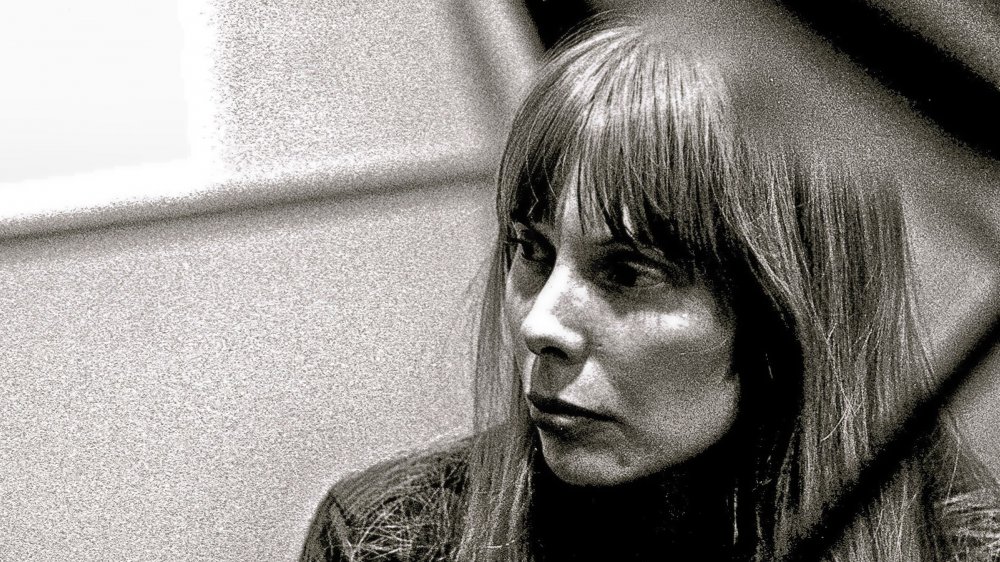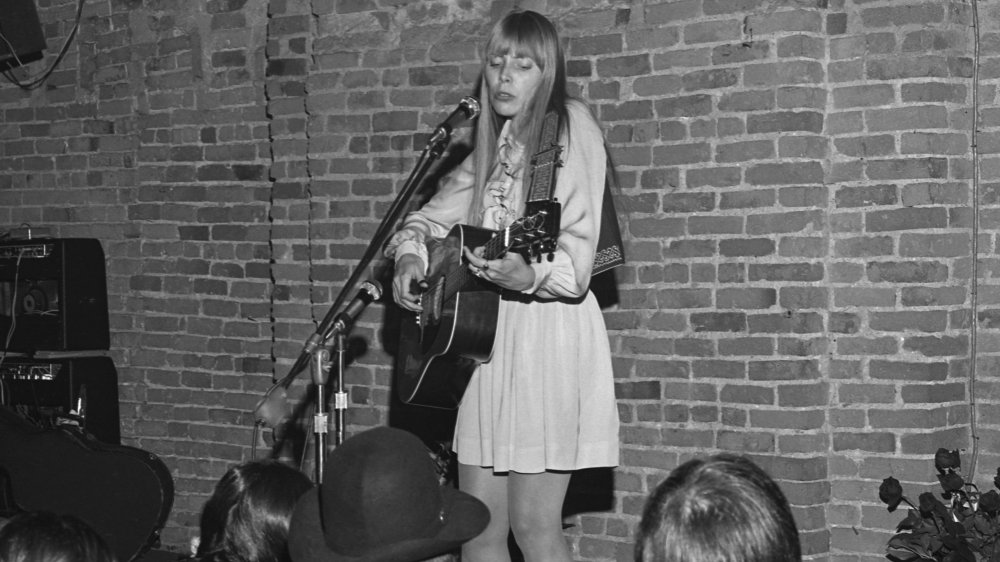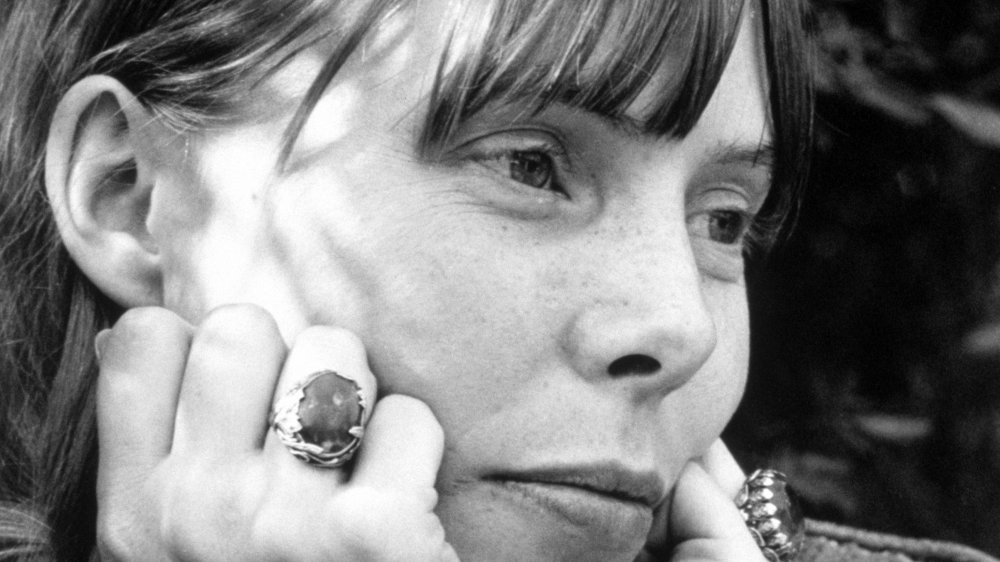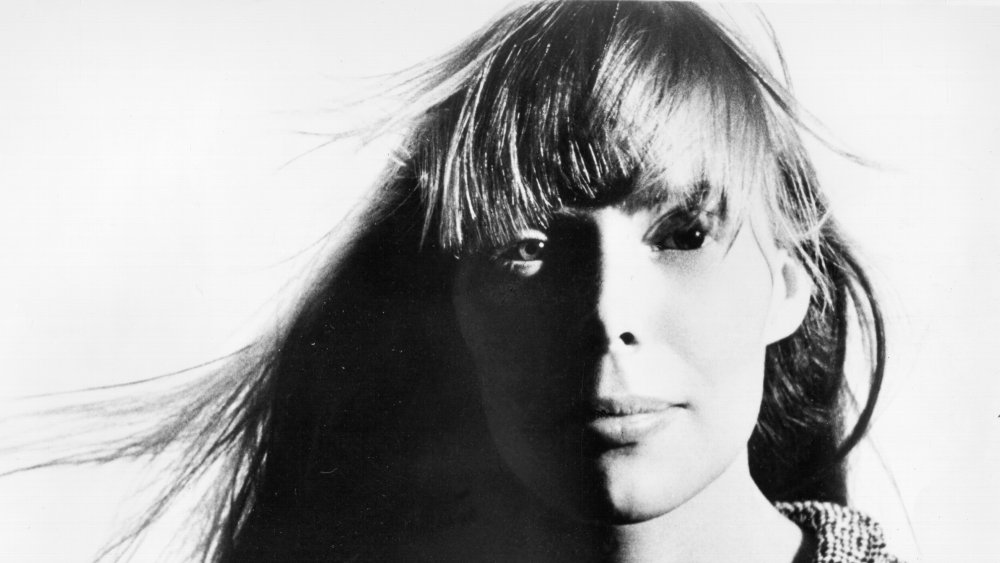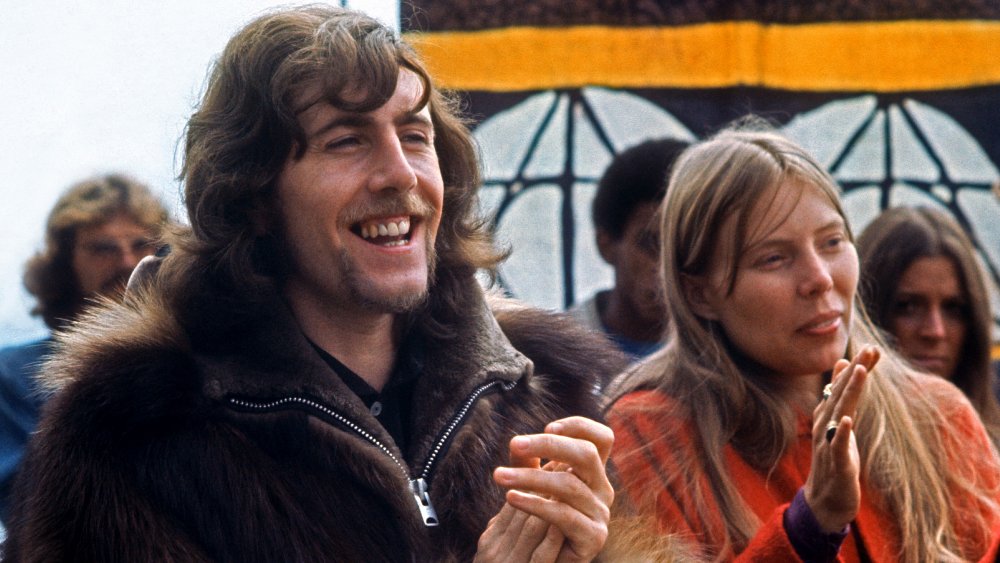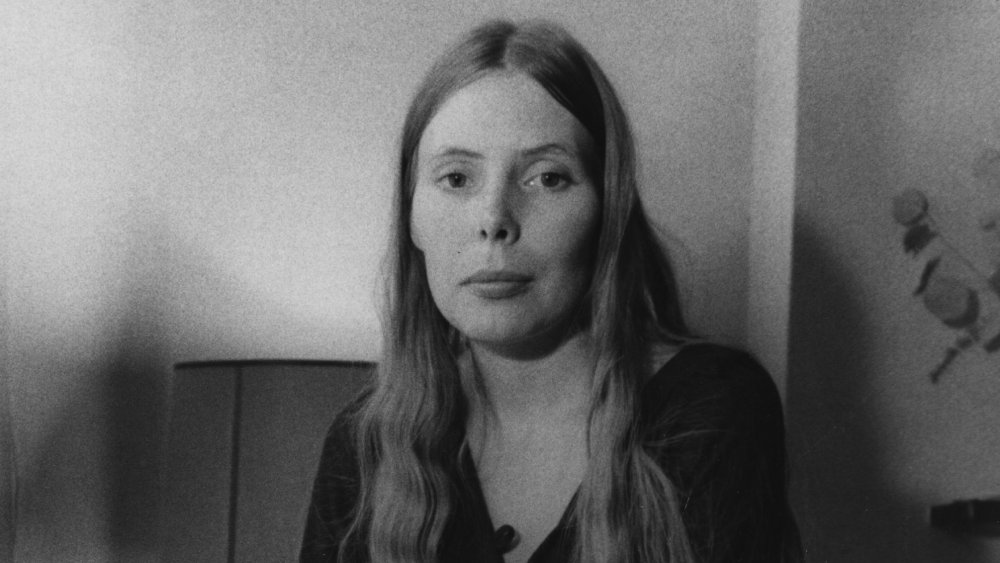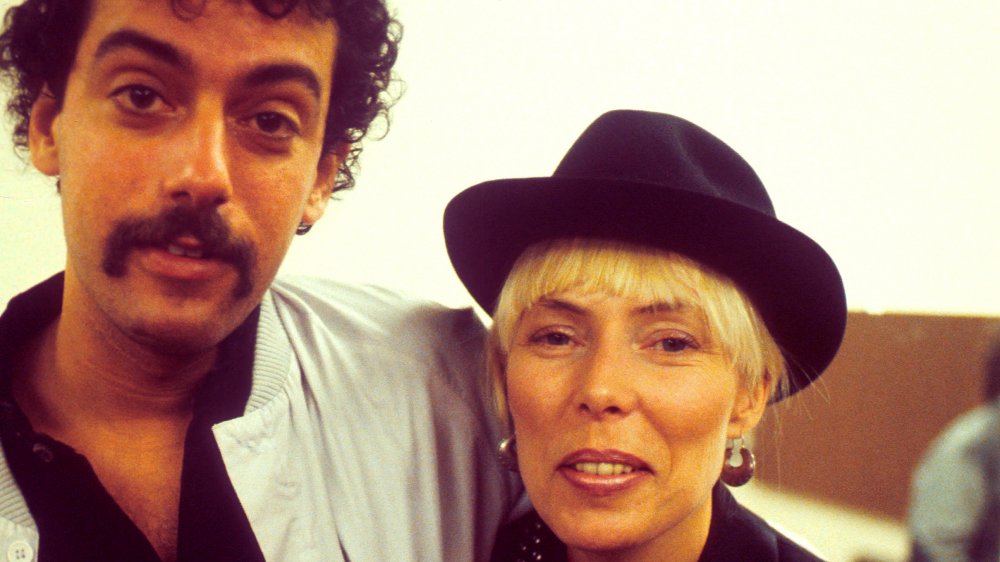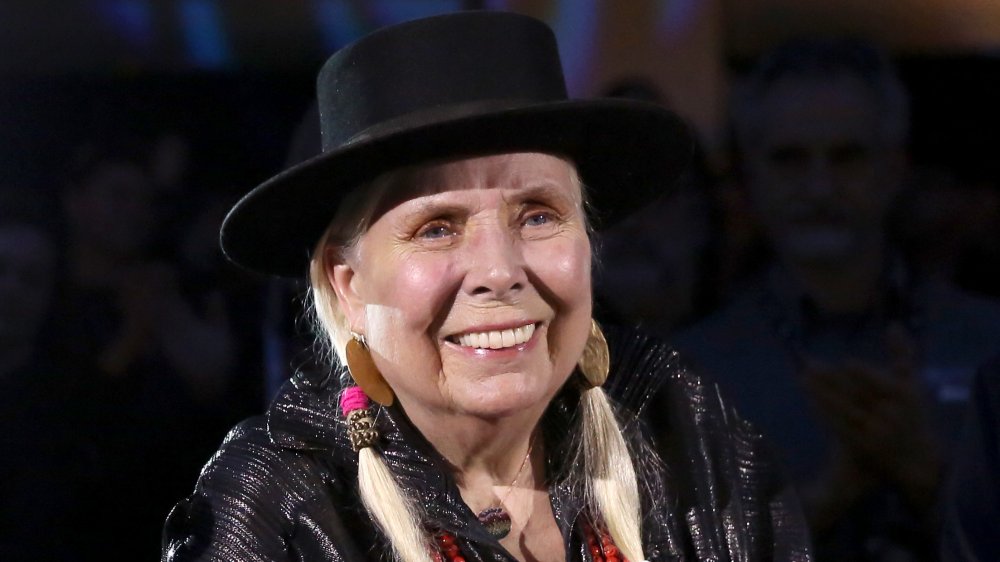Inside Joni Mitchell's Tragic Story
Iconoclastic and outspoken, singer Joni Mitchell has been a musical force for almost six decades. Called "one of the greatest songwriters of the past half century" by Rolling Stone, Mitchell began her career singing in tiny venues throughout Western Canada. In 1967, singer Judy Collins would score a Top 10 hit with her recording of Mitchell's "Both Sides Now," making the blonde folk singer a sought-after commodity. With her songs being covered by some of the most important artists of the era, Mitchell landed her own record deal in 1968.
Joni Mitchell's 1969 song "Woodstock" would provide the soundtrack for the Peace and Love Generation's closing years. Covered by folk rock powerhouse Crosby, Stills, Nash, and Young, Mitchell's words crystallized one of the most important musical events of the 1960s into the defining cultural moment of a generation. In the 1970s, she came into her own as a performer with the critically acclaimed albums Blue and Court and Spark. Soul-baring and confessional, Mitchell's '70s work perfectly captures the melancholy of fading '60s idealism. Gracefully weathering changing public tastes through the '80s, '90s, and 2000s, the nine-time Grammy winner has fearlessly followed her muse to become one of the most beloved and respected artists of all time
With musicians as diverse as Led Zeppelin and Prince claiming her as an influence, Mitchell has had a career that most singer-songwriters dream of. However, life has not always been kind. From personal heartbreak to failing health, this is Joni Mitchell's tragic story.
Joni Mitchell contracted polio at age nine
Born Roberta Joan Anderson on November 7, 1943, in the tiny town of Fort Macleod in Alberta, Canada, Joni Mitchell faced one of the greatest challenges of her life at an early age. At age nine, Mitchell contracted polio and was hospitalized during an outbreak.
Initially bedridden, a recovering Mitchell discovered her love of entertaining while singing for convalescing patients. In an interview with journalist and filmmaker Cameron Crowe, Mitchell opened up about how the disease led to her becoming a performer. "I was nine, and they put me in a polio ward over Christmas," Mitchell recalls. "They said I might not walk again and that I would not be able to go home for Christmas." However, no one was going to dampen young Joni Mitchell's holiday cheer. "I wouldn't go for it," Mitchell says. "So I started to sing Christmas carols, and I used to sing them real loud. When the nurse came into the room I would sing louder. [...] And I discovered I was a ham."
Ironically, Mitchell's bout with the crippling illness would influence her music in unforeseen ways. Unable to form conventional guitar chords because of weakness in her left hand, the singer experimented with alternate tunings that have since become part of her signature sound. Mitchell, cited by Rolling Stone as one of the 100 best guitarists of all time, has used up to 50 nonstandard tunings, allowing her to explore rhythm, harmony, and melody in unique and innovative ways.
Joni Mitchell was a teen misfit
Free-thinking and artistic, teenage Joni Mitchell had little use for high school. In 1979, she told Rolling Stone, "The way I saw the educational system from an early age was that it taught you what to think, not how to think." Music, dance, and the visual arts were far more important than the classes her Saskatoon, Saskatchewan, high school offered. Yet, even within the confines of an educational system she found frustrating, the budding artist and musician had one ally. "I was fortunate in the public school system to have one radical teacher," Mitchell remembers. "He was [...] a handsome spirited man and a reverer of spirit. [...] He drew out my poetry. [...] I wrote an epic poem in class — I labored to impress him. I got it back circled in red with 'cliché, cliché.' [...] At the bottom he said, 'Write about what you know, it's more interesting.'" Nevertheless, Mitchell flunked out of the 12th grade.
Joni Mitchell's teen years also saw her running with a rough crowd. Fortunately, she had the foresight to escape their influence. "There also came a stage when my friends who were juvenile delinquents suddenly became criminals. They could go into very dull jobs or they could go into crime. Crime is very romantic in your youth. I suddenly thought, 'Here's where the romance ends. I don't see myself in jail...'"
Joni Mitchell dropped out of art school
Joni Mitchell eventually earned her high school diploma by picking up her failing courses in summer school. Free of the academic constraints of high school, Mitchell was at last ready to embark on her lifelong dream of becoming a painter. Working as a waitress, she earned enough money to begin her formal education in the visual arts. She enrolled in the Alberta College of Art in Calgary, where she excelled in her classes. But, a year into her studies, she found the prevailing attitudes in art education just as stifling as high school. Not happy with the school's pigeonholing of students as either commercial or fine artists, Mitchell dropped out.
In a 1976 interview archived at JoniMitchell.com, she explains her frustration with the art school's focus on technical ability over creativity. "I found that I was an honor student at art school for the same reason that I was a bad student — an equal and opposite reason — because I had developed a lot of technical ability. [...] So I became pretty disillusioned with art college, even though I enjoyed being near the head of my class for the first time in my life."
Years later, Mitchell contends that art school had a negative effect on her painting. "Some of my art education has been something that I've had to undo," Mitchell explains. "It's been a long time coming for me to find myself as a painter because I was educated badly in that area."
An unexpected pregnancy leads to heartbreak
While attending the Alberta College of Art, Joni Mitchell supported herself as a department store model. While pursuing her studies, she developed an interest in music and taught herself to play guitar. Soon, the struggling art student was supplementing her income performing in Alberta coffeehouses.
Around this time, Joni Mitchell had a tryst with a handsome fellow artist named Brad MacMath. Following the fling, Mitchell discovered that she was pregnant. When MacMath found out, he abandoned Mitchell and left for California. Virtually penniless and fearing her parents' scorn, she fled to Toronto to give birth to the daughter she would name Kelly Dale Anderson. Unable to provide for the child, Mitchell gave her up for adoption. It was a decision that would haunt her and influence her music for the rest of her life, per The New Yorker.
In a 2017 interview, Mitchell relates the circumstances of her pregnancy. "I was the only virgin in art school," Mitchell says. "I had been holding on to this precious thing and I kind of stupidly let it go." Music became a way for the self-proclaimed "fallen woman" to hide. "I got called out immediately, and I had to create a smokescreen. The music was not of interest. This was a trick of fate because I didn't know I had the gift." Mitchell also takes issue with a commonly reported misconception: "Let's clear up something that people assume erroneously — that I gave up my daughter to further my career. This is so wrong. There was no career."
A marriage of convenience
As detailed by Biography, Joni Mitchell, then Roberta Joan Anderson, met folk musician Chuck Mitchell in the spring of 1965. Just 36 hours after meeting at Toronto's Penny Farthing Coffee House, the couple married. Soon after, they began performing as a duo, singing in Detroit-area folk music venues such as Chess Mate and The Raven Gallery.
However, the marriage was on shaky ground from the start. Joni has since described her time with Chuck Mitchell as a "marriage of convenience" that existed solely as a means for gaining custody of her daughter. In 1997, she told the Los Angeles Times, "One month into the marriage, he chickened out, I chickened out. The marriage had no basis, except to provide a home for the baby."
Yet, Chuck Mitchell's failure to follow through with helping Joni reunite with her baby wasn't their only source of marital strife. Chuck, a well-educated man several years Joni's senior, often made her feel intellectually inadequate. As recounted by The Ringer, citing from David Jaffe's 2017 biography of the singer Reckless Daughter: A Portrait of Joni Mitchell, Joni once lamented that she was "illiterate" in comparison to Chuck. "My husband's given me a complex that I haven't read anything," Joni once said. However, there's little doubt that Chuck Mitchell's condescending attitude toward his young wife was born from insecurity and the fact that she was rapidly outshining and outgrowing him as a musician and songwriter. By 1968, the marriage was over.
Love and addiction
By the end of the '60s, Joni Mitchell's star was on the rise. As her power as an artist grew, she also came into her own as a liberated woman. "I was in my mid-20s when I started to realize — with absolute exhilaration and a little fear — that my life was not going to play out on the same traditional feminine timeline as my mother and grandmothers," Mitchell told biographer David Jaffe.
Embracing the free love movement of the era, Mitchell left a string of famous paramours in her wake. In 1967, just prior to her divorce from Chuck Mitchell, she moved to L.A.'s Laurel Canyon and began a relationship with David Crosby of Crosby, Stills, Nash, and Young. Soon after, she fell for Crosby's bandmate Graham Nash (pictured above), with whom she seriously contemplated marriage. Throughout the 1970s, Mitchell was romantically linked with a number of famous men in the entertainment industry including James Taylor, Leonard Cohen, Jackson Browne, and Warren Beatty.
Along with a turbulent love life, success exposed Joni Mitchell to other excesses. In 1975, while touring with Bob Dylan's Rolling Thunder Revue, Mitchell became addicted to cocaine. "I realized you couldn't stay on that thing straight — you'd be the only one," she explained in a 2006 interview with The Ottawa Citizen. Although the drug fueled the writing of her 1976 album Hejira, it caused Mitchell to suffer bouts of insomnia. It would take her years to completely overcome her addiction.
Joni Mitchell's Blue period
Cited as an influential album by artists ranging from Bob Dylan to Taylor Swift, Joni Mitchell's fifth album, Blue, released in 1971, marked a turning point in her career. Blue is, at times, painfully personal. Rooted in Mitchell's depression, the album lays bare the whole of her turbulent life with songs that detail everything, from her many fractured relationships to a veiled ode to the child she gave up.
While recording Blue, Mitchell's melancholy seemed to imbue her with a nearly unbearable sense of empathy and insight. "I could see painfully — things about people I didn't want to know. I'd just look at a person and I'd know too much about them that I didn't want to know. And because everything was becoming transparent, I felt I must be transparent, and I cried," Mitchell tells biographer David Yaffe. "That's how I felt. Like my guts were on the outside. I wrote Blue in that condition."
Despite its highly confessional nature, Blue proved to be anything but cathartic for Mitchell. Writing and recording and then performing the songs from the album night after night in front of sold-out audiences took an emotional toll on the songwriter. "Some people would call it a nervous breakdown, but I just hit that pocket that everyone does on some point in their journey through their lives," Mitchell tells Marie Claire in a 2014 interview. "That identity crisis, that 'Who am I, really?' If you're lucky, it hits you early, like me."
A change in musical direction
In 1974, Joni Mitchell released the album Court and Spark. It was an instant hit. Charming both fans and critics with such signature songs as "Help Me," her only Top 10 Billboard single, Court and Spark was the pinnacle of Mitchell's commercial success.
Mitchell's next album, 1975's The Hissing of Summer Lawns, however, would mark a transition to a more experimental, jazz-influenced sound. Alienating longtime fans and confusing critics, the album took a drubbing from the press. Rolling Stone praised the songwriting but lambasted the music, calling the album "a great collection of pop poems with a distracting soundtrack." Mitchell feared for her career. In 1985, she told People, "If they had just said they'd hated it, I could have taken it," recalls Mitchell. "When other publications picked up the same attitude, I thought, 'I'll finish up this contract and quit making records.'"
Still, the singer-songwriter would not be deterred in her pursuit of musical experimentation. "You have two options," she told Cameron Crowe in 1979. "You can stay the same and protect the formula that gave you your initial success. They're going to crucify you for staying the same. If you change, they're going to crucify you for changing. [...] I'd rather be crucified for changing."
Joni Mitchell's miscarriage and divorce
1982 would prove an important year for Joni Mitchell. Entering her third decade in the music business, Mitchell took a break from jazz to explore pop music for her 11th studio album, Wild Things Run Fast. While recording the album, she met bassist Larry Klein. Klein (pictured above) would be instrumental in shaping the album's direction. The couple soon became romantically involved, and they married the same year. Klein and Mitchell were a creative powerhouse. Klein co-produced Mitchell's next album, 1985's Dog Eat Dog, which continued in the pop-oriented direction of Wild Things Run Fast.
Yet, 1985 found Joni Mitchell in the midst of another personal tragedy. Pregnant at 42, Mitchell miscarried in her first trimester. Klein decided to keep a professional commitment, leaving his wife to deal with the aftermath alone. Later, Mitchell would claim that Klein's choice to prioritize business over her well-being as a contributing factor to their divorce in 1994. Klein and Mitchell maintained an amicable relationship through their breakup. Although their marriage was over, their creative partnership remained in full bloom. Klein produced Mitchell's Grammy Award-winning album Turbulent Indigo, hailed by Rolling Stone as her best album since the 1970s.
Estranged from the daughter she gave up
Regret over giving her daughter up for adoption in 1965 haunted Joni Mitchell her entire life. In 1971, the singer-songwriter would memorialize the tragedy in the heartbreaking song "Little Green" from her iconic album Blue. Mitchell told the Los Angeles Times in 1997 that she "worried constantly" about her daughter in the intervening years since their separation.
Though Mitchell kept her secret for decades, a former art school classmate sold the story of her first pregnancy to a tabloid. Although Mitchell had secretly searched for her daughter without success for years, this betrayal by a one-time friend at last led to Mitchell's reunion with her long-lost daughter. Around the same time, Kelly Dale Anderson, now known as Kilauren Gibb, was searching for her birth parents. Her research led her to the unmistakable conclusion that she was the daughter of Joni Mitchell.
Mother and daughter met for the first time in 1997 and enjoyed a few years of happiness together. However, their relationship soured. In 2001, a physical altercation in which Mitchell allegedly slapped Gibb led to their estrangement. By the next decade, though, Mitchell and Gibb seemed to be on the road to reconciliation. Mitchell spoke about her relationship with her daughter in a 2013 interview with the Toronto Star. "She was pretty rough on me and conscripted my granddaughter, but we've worked through all of that. We reminisced about all the little tricks we pulled and the ways we can hurt each other. That's over."
Joni Mitchell's mystery ailment
For years, Joni Mitchell has claimed to suffer from a little-understood malady known as Morgellons Disease. Described by the Mayo Clinic as a controversial, unexplained skin condition "characterized by small fibers or other particles emerging from skin sores." Medical experts disagree about the nature of the ailment and continue to debate whether the disease even exists.
Mitchell opened up to the Los Angeles Times about her struggle with the mystery ailment in 2010. "I have this weird, incurable disease that seems like it's from outer space," Mitchell says. "Fibers in a variety of colors protrude out of my skin like mushrooms after a rainstorm: they cannot be forensically identified as animal, vegetable or mineral. [...] In America, the Morgellons is always diagnosed as 'delusion of parasites,' and they send you to a psychiatrist. I'm actually trying to get out of the music business to battle for Morgellons sufferers to receive the credibility that's owed to them."
A golden voice silenced
In March 2015, Joni Mitchell was found unconscious in her Los Angeles home. The singer was committed to intensive care, where she underwent tests which revealed she had suffered a crippling brain aneurysm.
Although an early report from musician David Crosby indicated that she couldn't speak, Mitchell's representatives denied this, stating that she "was speaking, and speaking well" but that she wasn't able to walk and would require extensive therapy.
Mitchell was soon well enough to return home, but her recovery is ongoing. Largely disappearing from the public eye for several years, the legendary performer has recently been making appearances. In 2018, she was spotted at a concert by former beau James Taylor. A hopeful Taylor spoke about Mitchell with The Guardian in early 2020. "She's coming back — which is an amazing thing to be able to do — and I wonder what she has to tell us about that."

